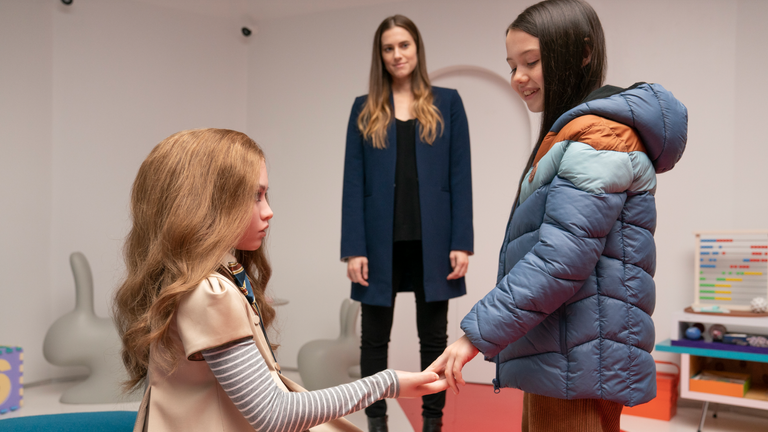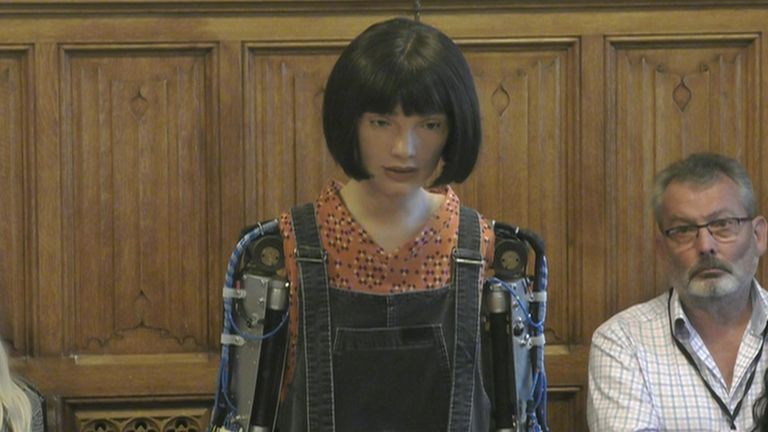Look beyond the enduring appeal of James Cameron’s Avatar sequel, which continues to storm box office charts more than a month after its release, and M3GAN is what’s enticing people to the cinema to start 2023.
The horror hit, which this week had a quick-fire sequel announced for 2025 after early takings of $100m (£81m), is stuffed with genre tropes long relied upon by Hollywood screenwriters.
Orphaned child? Check. Gnarly deaths? Check. Creepy doll? Yep, check.
But rather than be possessed by a demonic spirit or serial killer like its cinematic ancestors, Annabelle and Chucky, M3GAN is powered by something that could be far more terrifying: artificial intelligence (AI).
Scarily capable AI has been a crutch for filmmakers to lean on for decades – from Cameron’s Terminator to HAL in 2001: A Space Odyssey, audiences have found it an irresistible source of escapism.
But M3GAN debuts in a world where AI and its associated ethical dilemmas are all around us, from voice assistants that we’ve happily invited into our homes, to an artistic robot giving evidence in Westminster.
“Racing to create general-purpose AI because it’s cool, and not really thinking about the ramifications – this is just classic humans,” M3GAN’s director, Gerard Johnstone, tells Sky News.
‘Like tobacco in the 50s’
It’s that ethos that went into the design of the film’s titular character, pitched as the ultimate “cool babysitter” who would prove irresistible to adults and children alike.
M3GAN is the product of a high-tech toy company, portrayed with a morbidly amusing level of satire.
Because while Alexa and Siri may not express desire to inflict violence as M3GAN predictably ends up doing, the habits users form around her are not quite as far removed from reality.
Just as Alison Williams’ Gemma entrusts the doll to entertain her niece so she doesn’t have to, many parents let smartphones or smart speakers keep their children busy.
When M3GAN’s new best friend becomes angry at the prospect of her being switched off, it’s hard not to envisage similar scenes occurring when a child is told to put an iPad down.
“I was coming at it from the point of view of a parent,” says Johnstone.
“With how ubiquitous iPads and smartphones are – how can you educate your kids about the dangers of that, with screen time and things like that.
“I believe that we may look back and all this technology could be akin to tobacco in the 50s.
“I am literally having to stretch my hand out from iPhone cramps.”
The real robots that inspired M3GAN
While the “jumping off point” for Johnstone was Furby, the fluffy toy robot from the 90s, whose dead eyes seemed to pierce your very soul, M3GAN was partly inspired by an android named Sophia.
Made by Hanson Robotics, Sophia quickly gained an almost celebrity-like level of worldwide fame when she was switched on back in 2016.
Built by a former Disney theme parks engineer to mimic human behaviour through AI, speech recognition, and advanced robotics, Sophia was pitched as someone who could work in health care, customer service, and events.
A year later, she had appeared on chat shows, in music videos, was named the United Nations’ first “innovation champion” and given citizenship in Saudi Arabia, where – to some mockery – creator David Hanson suggested she could champion women’s rights.
But never mind all that. To Johnstone, “she looks a bit like a prop in a John Carpenter movie”.
“The more real, the more that seems to creep people out,” he adds.
As Catherine Bresling, who worked on the technology behind Amazon Alexa, told Sky News’ Big Ideas Live event, history is laden with attempts to assign human agency to technology.
And Sophia is not alone, Ai-Da – the aforementioned artist robot that gave evidence to a House of Lords enquiry into tech and creativity – has a similarly human aesthetic.
Her creator, Aidan Meller, told Sky News last year she would help people make sense of the “very big, sweeping changes that AI is bringing”.
Elon Musk, of course, got in on the act at the backend of 2022 by unveiling Tesla’s humanoid robot, which the billionaire wants to mass produce and sell to the public.
“I think Optimus is going to be incredible in five or 10 years, like mind-blowing,” he claimed.
And lest we forget that killer robots almost became public policy in San Francisco, where the police wanted to deploy machines equipped with explosives to counter “dangerous suspects”.
“The times we’re living in are really absurd,” notes Johnstone – and it’s hard to argue.
What next for M3GAN?
Science fiction writer Arthur C Clarke famously said that the best technology is “indistinguishable from magic”.
Few would argue that any of these creepy robots are close to that, while the idea of humanoid robots going rogue is not one that experts think should keep us up at night.
Indeed, M3GAN’s success suggests people are happy treating the prospect as a form of escapism above all else.
“Ultimately, I wanted this to be a fun movie,” says Johnstone. “But if people think seriously about things from a parenting point of view, an AI regulation point of view, that can only be a good thing.”
With two years to go until M3GAN 2.0, which Johnstone is not yet confirmed to direct, who knows what state our relationship with AI could be by then.
And while ChatGPT likely won’t be smart enough to get a joint writing credit (Johnstone’s tried it, it has limits), Hollywood will need to keep up.
“Whether it’s M3GAN 2 or something else, the conversation is evolving,” he tells Sky News. “It’s important that we consider how the audience and consumers are being affected by these products and what that’s doing to us psychologically. We need to stay ahead of the conversation.”




